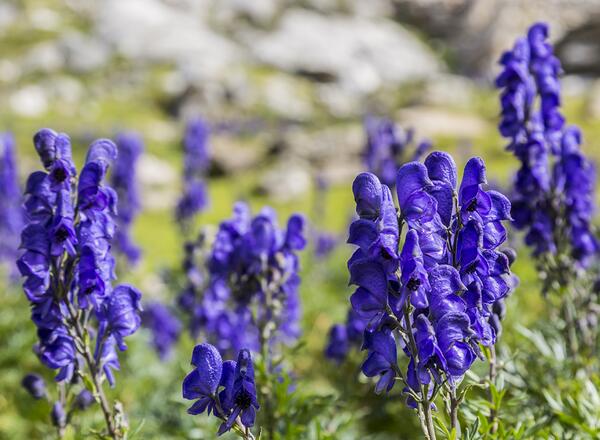Monkshood
Couldn't load pickup availability
Description
Monkshood: A Stunning and Toxic Beauty for Your Garden
Monkshood (Aconitum), also known as Wolf's Bane or Helmet Flower, is a striking perennial known for its unique, hood-shaped blossoms that resemble a monk's cowl. With its bold colors and dramatic appearance, Monkshood adds an element of mystery and beauty to any garden. However, despite its alluring look, Monkshood is highly toxic, so care should be taken when handling it. This plant thrives in cool, moist environments and is perfect for gardeners seeking a striking addition to their perennial garden, particularly in shady or woodland settings.
Key Features
- Distinctive Hood-Shaped Flowers: Monkshood’s most distinctive feature is its unique flowers, which resemble a hood or helmet. These striking blooms come in a variety of colors, with deep purples and blues being the most common, though white, yellow, and pink varieties also exist. The flower spikes can grow up to 4 feet tall, making them a dramatic focal point in the garden.
- Attractive Foliage: In addition to its showy flowers, Monkshood has deeply lobed, dark green foliage that provides a nice backdrop to the vibrant blooms. The foliage adds texture and interest to your garden throughout the growing season.
- Height and Structure: Monkshood is a tall perennial, typically growing 2 to 4 feet in height. The plants form sturdy, upright stems, making them ideal for adding vertical interest to the back of flower borders or garden beds.
- Perfect for Shaded Areas: This plant thrives in partial to full shade, making it an excellent choice for woodland gardens or shaded spots where many other plants might struggle to grow. It can also tolerate moist, well-drained soil, which is ideal for adding to the more challenging corners of your garden.
- Toxicity: It’s important to note that Monkshood is highly toxic if ingested and can cause serious harm if handled improperly. It should be planted with caution, especially in gardens with children or pets. Always wear gloves when handling the plant and ensure it’s kept out of reach of animals and small children.
Care Instructions
Light
Monkshood thrives in partial to full shade. It performs best in areas that are shielded from direct sunlight, such as under trees, along shaded garden borders, or in woodland settings. It can tolerate some morning sunlight but should be protected from the harsh midday sun to prevent the flowers from fading.
Watering
This plant enjoys moist, well-drained soil. Keep the soil evenly moist but not waterlogged, as Monkshood prefers a cool, moist environment. Water regularly during dry spells, but ensure the soil doesn’t become soggy, as excessive moisture can cause root rot.
Soil
Monkshood prefers fertile, well-draining, slightly acidic to neutral soil. It thrives in rich, loamy soils that retain moisture while providing good drainage. Adding organic matter like compost can help improve the soil structure and moisture retention, making it ideal for this plant.
Temperature
Hardy in USDA zones 3–7, Monkshood does well in cooler climates and prefers moderate temperatures. It is particularly suited to areas with cool summers and winter frost, which help the plant remain dormant during the colder months.
Plant Dimensions
- Height: Typically grows between 2 to 4 feet tall, creating a towering presence in your garden.
- Spread: Monkshood typically has a spread of 1 to 2 feet, creating a compact yet tall mound that adds vertical interest to garden beds.
Why Choose Monkshood?
Monkshood is an exquisite plant that offers dramatic beauty with its unique flower shape and vibrant colors. Perfect for shaded areas, it adds elegance and height to any garden, particularly in woodland or shaded settings. While it requires careful handling due to its toxicity, its striking blooms and foliage make it an appealing choice for experienced gardeners looking for something unique and eye-catching. Whether used in flower borders or as an accent plant, Monkshood provides a touch of mystery and allure to any garden.











